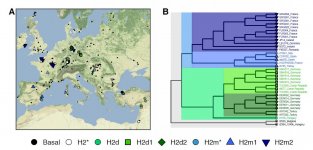bicicleur 2
Regular Member
- Messages
- 6,367
- Reaction score
- 1,401
- Points
- 113
Here we introduce a new DNA enrichment assay, coined YMCA (Y-mappable capture assay),
that targets the "mappable" regions of the NRY. We show that compared to low-coverage shotgun
sequencing and 1240K capture, YMCA significantly improves the coverage and number of sites
hit on the NRY, increasing the number of Y-haplogroup informative SNPs, and allowing for the
identification of previously undiscovered variants.

I'm impressed.
that targets the "mappable" regions of the NRY. We show that compared to low-coverage shotgun
sequencing and 1240K capture, YMCA significantly improves the coverage and number of sites
hit on the NRY, increasing the number of Y-haplogroup informative SNPs, and allowing for the
identification of previously undiscovered variants.

I'm impressed.

